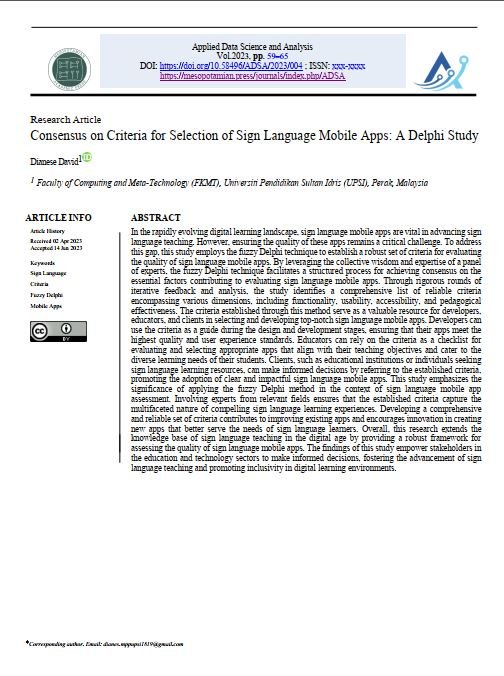Consensus on Criteria for Selection of Sign Language Mobile Apps: A Delphi Study
Main Article Content
Abstract
In the rapidly evolving digital learning landscape, sign language mobile apps are vital in advancing sign
language teaching. However, ensuring the quality of these apps remains a critical challenge. To address
this gap, this study employs the fuzzy Delphi technique to establish a robust set of criteria for evaluating
the quality of sign language mobile apps. By leveraging the collective wisdom and expertise of a panel
of experts, the fuzzy Delphi technique facilitates a structured process for achieving consensus on the
essential factors contributing to evaluating sign language mobile apps. Through rigorous rounds of
iterative feedback and analysis, the study identifies a comprehensive list of reliable criteria
encompassing various dimensions, including functionality, usability, accessibility, and pedagogical
effectiveness. The criteria established through this method serve as a valuable resource for developers,
educators, and clients in selecting and developing top-notch sign language mobile apps. Developers can
use the criteria as a guide during the design and development stages, ensuring that their apps meet the
highest quality and user experience standards. Educators can rely on the criteria as a checklist for
evaluating and selecting appropriate apps that align with their teaching objectives and cater to the
diverse learning needs of their students. Clients, such as educational institutions or individuals seeking
sign language learning resources, can make informed decisions by referring to the established criteria,
promoting the adoption of clear and impactful sign language mobile apps. This study emphasizes the
significance of applying the fuzzy Delphi method in the context of sign language mobile app
assessment. Involving experts from relevant fields ensures that the established criteria capture the
multifaceted nature of compelling sign language learning experiences. Developing a comprehensive
and reliable set of criteria contributes to improving existing apps and encourages innovation in creating
new apps that better serve the needs of sign language learners. Overall, this research extends the
knowledge base of sign language teaching in the digital age by providing a robust framework for
assessing the quality of sign language mobile apps. The findings of this study empower stakeholders in
the education and technology sectors to make informed decisions, fostering the advancement of sign
language teaching and promoting inclusivity in digital learning environments.
Article Details
Issue
Section

This work is licensed under a Creative Commons Attribution 4.0 International License.
Deprecated: json_decode(): Passing null to parameter #1 ($json) of type string is deprecated in /home/u273879158/domains/mesopotamian.press/public_html/journals/plugins/generic/citations/CitationsPlugin.php on line 68
How to Cite
References
D. Bragg et al., Sign Language Recognition, Generation, and Translation: An Interdisciplinary Perspective. 2019, pp. 16-31.
J. K. a. B. Klímová, "Use of Smartphone Applications in English Language Learning—A Challenge for Foreign Language Education," education sciences, 2019, doi: 10.3390/educsci9030179.
G. Abou Haidar, R. Achkar, D. Salhab, A. Sayah, and F. Jobran, "Sign language translator using the back propagation algorithm of an M.L.P.," in 2019 7th International Conference on Future Internet of Things and Cloud Workshops (FiCloudW), 2019: IEEE, pp. 31-35.
H. Haron, H. Samad, F. Md Diah, and H. Yusof, "E-LEARNING APPROACH USING MOBILE APPS: MALAYSIAN SIGN LANGUAGE FOR DUMB AND DEAF," no. 1, pp. 1-7%V 1, 2019-06-23 2019. [Online]. Available: https://myjms.mohe.gov.my/index.php/ijarti/article/view/5991%J International Journal of Advanced Research in Technology and Innovation.
R. L. Romero et al., "Modifying the Mobile App Rating Scale With a Content Expert: Evaluation Study of Deaf and Hard-of-Hearing Apps," vol. 7, no. 10, 2019.
M. G. Vintimilla, D. Alulema, D. Morocho, M. Proano, F. Encalada, and E. Granizo, "Development and implementation of an application that translates the alphabet and the numbers from 1 to 10 from sign language to text to help hearing impaired by Android mobile devices," in 2016 IEEE International Conference on Automatica (ICA-ACCA), 2016: IEEE, pp. 1-5.
F. K. Ryan Lee Romero, Mark Hart, Amanda Ojeda, Itai Meirom, Stephen Hardy., "Modifying the Mobile App Rating Scale With a Content Expert: Evaluation Study of Deaf and Hard-of-Hearing Apps," JMIR Mhealth Uhealth 2019, vol. 7, 2019, doi: 10.2196/14198.
K. A. Dawood, K. Y. Sharif, A. A. Ghani, H. Zulzalil, A. A. Zaidan, and B. B. Zaidan, "Towards a unified criteria model for usability evaluation in the context of open source software based on a fuzzy Delphi method," Information and Software Technology, vol. 130, p. 106453, 2021/02/01/ 2021, doi: https://doi.org/10.1016/j.infsof.2020.106453.
A. A. Alsalem MA, Albahri OS, Dawood KA, Mohammed RT, Alnoor A, Zaidan AA, Albahri AS, Zaidan BB, Jumaah FM, Al-Obaidi JR., "Multi-criteria decision-making for coronavirus disease 2019 applications: a theoretical analysis review.," Artificial Intelligence Review, vol. 1, p. 84 2022, doi: 10.1007/s10462-021-10124-x
H. I. Rahmat Dapari, Rosnah Ismail, Noor Hassim Ismail, "Application of Fuzzy Delphi in the Selection of COPD Risk Factors among Steel Industry Workers," National Research Institute of Tuberculosis and Lung Disease, vol. 16, pp. 46-52, August 25th 2016 2017.
A. F. H. Mohamed Yusoff, Azmil & Muhamad, Norhisham & Wan Hamat, Wan., "Application of Fuzzy Delphi Technique Towards Designing and Developing the Elements for the e-PBM PI-Poli Module (Aplikasi Teknik Fuzzy Delphi Terhadap Elemen-Elemen Reka Bentuk Dan Pembangunan Modul e-PBM PI-Poli)," Asian Journal of University Education, vol. 17, pp. 292-304, 2021, doi: 10.24191/ajue.v17i1.12625. .
F. Smarandache, J. E. Ricardo, E. G. Caballero, M. Y. L. Vázquez, and N. B. J. I. S. Hernández, "Delphi method for evaluating scientific research proposals in a neutrosophic environment," vol. 34, pp. 204-213, 2020.
P.-L. Chang, C.-W. Hsu, and P.-C. Chang, "Fuzzy Delphi method for evaluating hydrogen production technologies," International Journal of Hydrogen Energy, vol. 36, no. 21, pp. 14172-14179, 2011.
C.-H. Cheng and Y. Lin, "Evaluating the best main battle tank using fuzzy decision theory with linguistic criteria evaluation," European journal of operational research, vol. 142, no. 1, pp. 174-186, 2002.
S. Bodjanova, "Median alpha-levels of a fuzzy number," Fuzzy Sets and Systems, vol. 157, no. 7, pp. 879-891, 2006.
H.-C. Chu and G.-J. Hwang, "A Delphi-based approach to developing expert systems with the cooperation of multiple experts," Expert systems with applications, vol. 34, no. 4, pp. 2826-2840, 2008.
